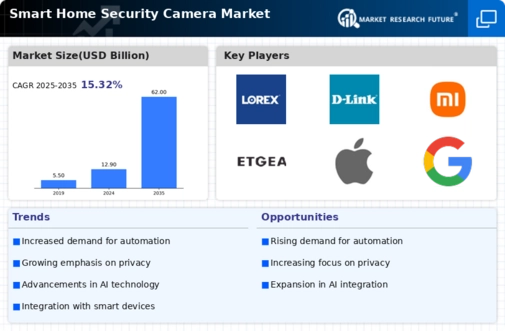Technological Advancements
Technological advancements play a pivotal role in shaping the Smart Home Security Camera Market. Innovations such as high-definition video quality, night vision capabilities, and cloud storage solutions have significantly enhanced the functionality of security cameras. Recent market data suggests that the integration of artificial intelligence and machine learning into these devices has led to improved threat detection and response times. As technology continues to evolve, consumers are increasingly drawn to smart home security cameras that offer advanced features, such as facial recognition and real-time alerts. This trend not only enhances user experience but also drives competition among manufacturers to develop cutting-edge products. Consequently, the Smart Home Security Camera Market is poised for sustained growth as technological advancements continue to redefine consumer expectations.
Increased Consumer Awareness
The Smart Home Security Camera Market experiences a notable surge in demand as consumer awareness regarding home security escalates. With rising crime rates and the proliferation of information through digital platforms, individuals are increasingly prioritizing the safety of their homes. This heightened awareness is reflected in market data, indicating that the demand for smart home security cameras has grown by approximately 25% over the past year. Consumers are now more informed about the features and benefits of these devices, leading to a shift in purchasing behavior towards advanced security solutions. As a result, manufacturers are compelled to innovate and enhance their offerings, ensuring that they meet the evolving expectations of security-conscious consumers. This trend is likely to continue, further propelling the Smart Home Security Camera Market forward.
Rising Adoption of Smart Home Devices
The Smart Home Security Camera Market is significantly influenced by the rising adoption of smart home devices. As households increasingly integrate various smart technologies, the demand for compatible security solutions has surged. Market data indicates that nearly 40% of households now utilize at least one smart home device, creating a synergistic effect that drives the need for smart security cameras. Consumers are drawn to the convenience of managing multiple devices through a single platform, which enhances the appeal of integrated security systems. This trend is likely to continue as more individuals recognize the benefits of a connected home environment. Consequently, the Smart Home Security Camera Market stands to benefit from this growing trend, as manufacturers develop products that seamlessly integrate with existing smart home ecosystems.
Growing Demand for Remote Monitoring Solutions
The Smart Home Security Camera Market is witnessing a growing demand for remote monitoring solutions, driven by the increasing need for convenience and peace of mind among consumers. As lifestyles become busier, individuals seek ways to monitor their homes from anywhere, at any time. Recent statistics indicate that approximately 60% of consumers prefer security systems that offer mobile app integration for remote access. This trend has prompted manufacturers to focus on developing user-friendly applications that allow real-time monitoring and control of security cameras. The ability to receive instant notifications and view live feeds enhances the overall security experience, making remote monitoring a key driver in the Smart Home Security Camera Market. As this demand continues to rise, companies are likely to invest in enhancing their remote monitoring capabilities.
Regulatory Support for Home Security Solutions
Regulatory support for home security solutions is emerging as a significant driver in the Smart Home Security Camera Market. Governments are increasingly recognizing the importance of enhancing public safety and are implementing policies that encourage the adoption of security technologies. Recent initiatives have included tax incentives for homeowners who invest in security systems, which has led to a noticeable uptick in sales of smart home security cameras. This regulatory backing not only fosters consumer confidence but also stimulates market growth by making security solutions more accessible. As regulations continue to evolve, the Smart Home Security Camera Market is likely to experience further expansion, driven by both consumer demand and supportive government policies.

















Leave a Comment